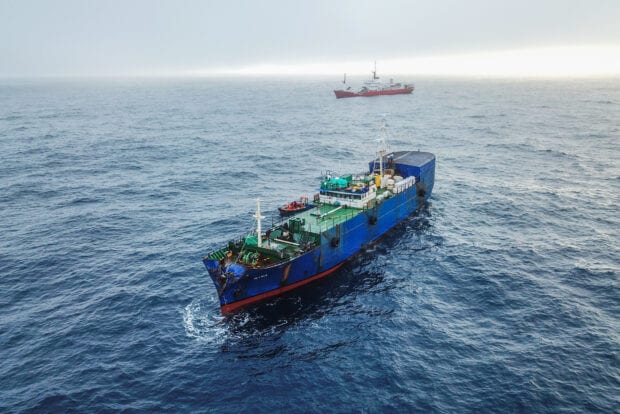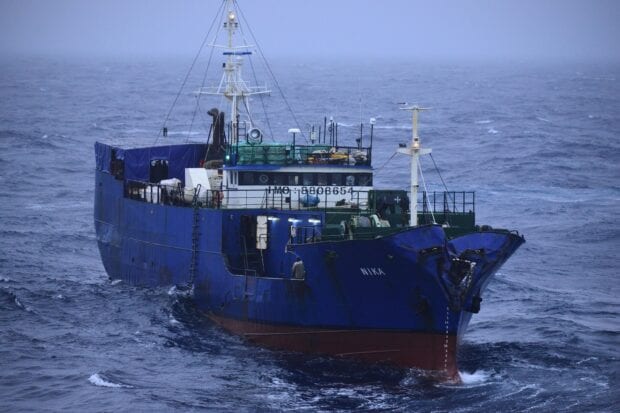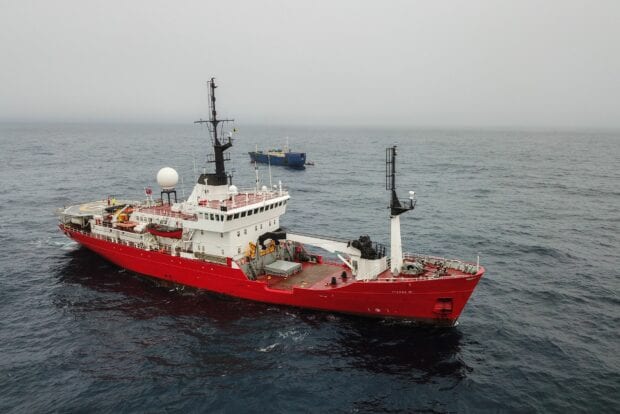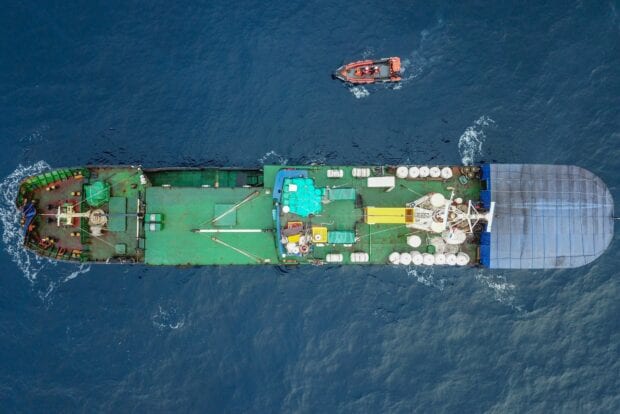On the International Day against Illegal Fishing, it’s good to be reminded about the challenges illegal fishing presents to the UK Overseas Territories (UKOTs) within the Blue Belt Programme and the measures that they take to reduce the risks to their marine environments.
One of the chief criticisms levied against Marine Protected Areas (MPAs) by some observers, is that they are ‘paper parks’ – legally established protected areas but where some believe their marine protection activities are insufficient to make a major and lasting difference.
However, Blue Belt’s UKOT’s (St Helena, Ascension Island and Tristan da Cunha, British Antarctic Territory, British Indian Ocean Territory, Pitcairn Island, South Georgia and the South Sandwich Islands) are challenging that head on, with strong governance to help with tackling Illegal, Unreported and Unregulated (IUU) fishing in their marine protected areas with equally robust compliance and enforcement strategies.
IUU fishing can present clear problems for UKOTs when managing their MPAs. Firstly, there is the risk to the precious marine environment, the contribution to over-fishing and the impact on a territory’s own fishing industry.
The facts
For example, through our work with the European Maritime Safety Agency (EMSA) and OceanMind, the not for profit organisation that empowers fisheries authorities and seafood buyers to understand the compliance of fishing around the world, in the last year we have:
- Provided case 313 Intelligence Reports, 261 of which were in BIOT
- Spent 241 days in the surveillance of suspicious illegal activity
- In the last year alone 94.5million square kilometres of satellite imagery was assessed for any IUU fishing
In addition, from 2016-20 the programme analysed over 142 million square kilometres of satellite imagery to detect illegal unregulated and unreported fishing across the UKOTs.
The MV NIKA
One particular incident – the interception of the MV NIKA in the South Atlantic in 2019 – is a stand out example on how a UK overseas territory – South Georgia and the South Sandwich Islands (SGSSI), working with a range of international partners, including Interpol, and assisted by the Blue Belt team, was able to initiate the vessel’s seizure and successful prosecution by Panama and Indonesia.

The MV NIKA was a vessel with a dubious past – including being wanted in several jurisdictions and since 2006, it had changed its name and flag state seven times - often a sign of trying to hide illegal activity. Boats involved in illegal fishing often obscure their origins by using foreign flags, a system that complicates monitoring and oversight by allowing ships to register outside of the vessel owner's country.
What follows is a case study of international collaboration that led to the removal of an illegal fishing vessel and a clear demonstration of how effective robust surveillance and enforcement procedures can be in protecting MPAs.
On 31 May 2019 a vessel identifying as the bulk carrier “Jewel of Nippon” was observed on the Automatic Identification System (AIS) in the South Georgia and South Sandwich Island Maritime Zone. It is believed that it entered the zone on 30 May.
Suspicions quickly began to form as to the genuine identity of this vessel as it was highly unusual to see a bulk carrier at that location. The AIS tracker indicated that the vessel might be involved in fishing activity – rather than transiting the Exclusive Economic Zone. At the same time, SGSSI’s licensed fleet also reported the presence of an unidentified vessel in the same vicinity. Further investigation strongly suggested that the vessel was 'cloning' the identity of the bulk carrier 'Jewel of Nippon' (which was simultaneously reporting a position in SE Asia) and that the vessel was in fact the Panamanian flagged, Korean owned fishing vessel 'NIKA'.

On 1 June, the SGSSI’s patrol vessel Pharos SG was planning to intercept the NIKA, suspecting that it had been fishing whilst in the prohibited fishing zone, when it began to head west and left South Georgia waters. A request for assistance was made to the Falkland Islands and their patrol vessel, the Protegat, visually confirmed on 4 June that the vessel within the Falklands EEZ was indeed the MV NIKA. Unfortunately, bad weather denied the Protegat the opportunity to inspect the vessel, although they did get photographic evidence of its presence in the prohibited waters.
The NIKA then headed east back into the SGSSI maritime zone and on 6 June was intercepted by the Pharos. After complying with the request to come alongside, it refused to enter the 12 nautical mile zone and so was escorted to more sheltered waters near to South Georgia. On 8 June it was inspected by two SGSSI fisheries officers – who were also appointed as UK Convention for the Conservation of Antarctic Marine Living Resources (CCAMLR) inspectors.
The inspectors found significant damage to the bow of the vessel – the result of a possible collision with an iceberg. They also discovered fishing gear and bait on board, with evidence of deep water species, soft corals and other marine products scattered on the deck, but no bulk catch. It was then expelled from SGSSI waters and headed to China for repairs to its bow.
Following the inspection within South Georgia waters, the Government of SGSSI brought the MV NIKA to INTERPOL’s (The International Criminal Police Organization) attention through the UK government’s Marine Management Organisation and OceanMind.

On 12 July, two Indonesian fishery patrol boats detected the NIKA in the middle of the Strait of Malacca – which is one of the busiest and most important shipping lanes in the world.
Intelligence sharing between the Indonesian authorities, INTERPOL and Global Fishing Watch, led to the NIKA being captured by Indonesian patrol boats, ORCA 2 and ORCA 3 and taken under custody to harbour. The vessel had 18 Russian and 10 Indonesian crew members aboard.
It was discovered that the NIKA was owned by the same company as the STS 50, a blacklisted vessel known to be involved in illegal fishing, which was intercepted in Indonesia in 2018. It was suspected of falsifying registration documents and claiming it was a bulk carrier instead of a fishing boat in order to avoid detection. Despite being registered as a general cargo vessel, the MV NIKA was found with fish processing facilities on board. It was equipped with a pot handling and operating system and approximately 200 crab pots were lashed in place as well as herring for bait.

The case against the MV NIKA
The MV NIKA:
- was suspected of falsifying a certificate of registration in Panama stating itself to be a General Cargo Vessel, while MV NIKA is suspected of catching and/or transporting fish.
- had conducted unlicensed fishing and/or transhipment (where cargo or a container is moved from one vessel to another while in transit to its final destination, often to avoid official checks at ports which would confirm that the fish had been legally caught or not) within the UK Overseas Territories of South Georgia and the South Sandwich Islands and the Falklands Island
- used AIS data belonging to another ship named JEWEL OF NIPPON to obscure the MV NIKA's true identity when it entered CCAMLR territory to catch fish.
The Verdict
On 27 February 2020, the Indonesian Supreme Court found the vessel's captain guilty for violating Indonesian fisheries law; the owners were given a fine of IDN Rp300.000.000 (approximately $21,226); and the NIKA, all its shipborne equipment and fishing gear were forfeited. The owner submitted an appeal but lost in the supreme court.
Additionally, the MV NIKA was added to CCAMLR Contracting Party IUU Vessel List for 2020/21 for fishing without a licence and has been de-flagged by Panama.
Conclusion
There is no doubt that having key organisations and nation states working together led to the removal of a notorious vessel and its illegal activities. It was routine satellite surveillance of the MPA - as part of SGSSI’s compliance and enforcement -alongside the suspicions of SGSSI’s licensed patrol boat that initiated what was to become the downfall of the MV NIKA.
But satellite technology is only one piece in the surveillance toolbox for UKOTs protecting their MPAs – innovative technology is also very much in evidence, with drones, passive acoustic devices; Synthetic Aperture Radar (SAR) satellites either in trial or operational alongside the more traditional AIS technology and patrol vessels. UKOTs take protecting their oceans very seriously and are determined to use the very best in state of the art technology, hand in hand with information sharing to both deter and prosecute those who would engage in activities that would threaten the protection of their waters.